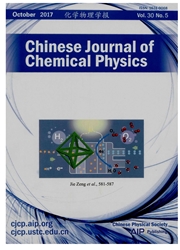

 中文摘要:
中文摘要:
研究苯在30Torr 和1360-1820K下的热解过程.利用同步辐射真空紫外光电离质谱技术对热解产物进行了检测,并对其随温度变化的摩尔分数曲线进行了测量.建立了一个低压苯热解动力学模型,并结合生成速率分析展示了燃料分解和芳烃生长过程中的主要反应网络.结果显示举的分解主要通过氢提取反应生成苯基进行,部分通过单分子解离反应生成丙炔基或苯基进行,并终止于乙炔、丁二炔及1,3,5-己三炔等具有高热稳定性的聚炔烃类物种的生成.此外,低压苯热解中的芳烃生长过程起始于苯和苯基,并主要受到偶数碳增长机理控制.这是由于奇数碳增长机理所依赖的C5和C7物种在低压苯热解中很难生成.
 英文摘要:
英文摘要:
Pyrolysis of benzene at 30 Torr was studied from 1360 K to 1820 K in this work. Synchrotron vacuum ultraviolet photoionization mass spectrometry was employed to detect the pyroly- sis products such as radicals, isomers and polycyclic aromatic hydrocarbons, and measure their mole fraction profiles versus temperature. A low-pressure pyrolysis model of benzene was developed and validated by the experimental results. Rate of production analysis was performed to reveal the major reaction networks in both fuel decomposition and aromatic growth processes. It is concluded that benzene is mainly decomposed via H-abstraction reaction to produce phenyl and partly decomposed via unimolecular decomposition reac- tions to produce propargyl or phenyl. The decomposition process stops at the formation of acetylene and polyyne species like diacetylene and 1,3,5-hexatriyne due to their high thermal stabilities. Besides, the aromatic growth process in the low-pressure pyrolysis of benzene is concluded to initiate from benzene and phenyl, and is controlled by the even carbon growth mechanism due to the inhibited formation of C5 and C7 species which play important roles in the odd carbon growth mechanism.
 同期刊论文项目
同期刊论文项目
 同项目期刊论文
同项目期刊论文
 Influences of low atmospheric pressure on downward flame spread over thick PMMA salbs at different a
Influences of low atmospheric pressure on downward flame spread over thick PMMA salbs at different a Product Identification and Mass Spectrometric Analysis of n-Butane and i-Butane Pyrolysis at Low Pre
Product Identification and Mass Spectrometric Analysis of n-Butane and i-Butane Pyrolysis at Low Pre Fabrication and characterization of graphene-reinforced waterborne polyurethane nanocomposite coatin
Fabrication and characterization of graphene-reinforced waterborne polyurethane nanocomposite coatin Effects of low atmospheric pressure on combustion characteristics of polyethylene and polymethyl met
Effects of low atmospheric pressure on combustion characteristics of polyethylene and polymethyl met Comparative study on the synergistic effect of POSS and graphene with melamine phosphate on the flam
Comparative study on the synergistic effect of POSS and graphene with melamine phosphate on the flam Effects of sample width and inclined angle on flame spread across expanded polystyrene surface in pl
Effects of sample width and inclined angle on flame spread across expanded polystyrene surface in pl Photoionization Mass Spectrometric and Kinetic Modeling Investigation on Low-Pressure Pyrolysis of B
Photoionization Mass Spectrometric and Kinetic Modeling Investigation on Low-Pressure Pyrolysis of B Theoretical and experimental study of width effects on horizontal flame spread over extruded and exp
Theoretical and experimental study of width effects on horizontal flame spread over extruded and exp Experimental and numerical investigation of premixed flame propagation with distorted tulip shape in
Experimental and numerical investigation of premixed flame propagation with distorted tulip shape in Cobalt oxide/graphene composite for highly efficient CO oxidation and its application in reducing th
Cobalt oxide/graphene composite for highly efficient CO oxidation and its application in reducing th Experimental study on the characteristic stages of premixed hydrogen-air flame propagation in a hori
Experimental study on the characteristic stages of premixed hydrogen-air flame propagation in a hori Influence of Different Metal Oxides on the Thermal, Combustion Properties and Smoke Suppression in E
Influence of Different Metal Oxides on the Thermal, Combustion Properties and Smoke Suppression in E Experimental study of the flash point of flammable liquids under different altitudes in Tibet platea
Experimental study of the flash point of flammable liquids under different altitudes in Tibet platea Experimental study on the effect of the igniter position on piloted ignition of polymethylmethacryla
Experimental study on the effect of the igniter position on piloted ignition of polymethylmethacryla Flame retardancy and thermal degradation behaviors of phosphate in combination with POSS in polylact
Flame retardancy and thermal degradation behaviors of phosphate in combination with POSS in polylact Investigation on the pyrolysis and oxidation of toluene over a wide range conditions. I. Flow reacto
Investigation on the pyrolysis and oxidation of toluene over a wide range conditions. I. Flow reacto 期刊信息
期刊信息
